Content
- 1 Barberry Thunberg - description
- 2 Types of barberry Thunberg
- 3 Planting and grooming recommendations
- 4 Evergreen beauties for a flower garden
- 5 Healer plant
- 6 General characteristics of Thunberg barberry varieties
- 7 Barberry Thunberg Atropurpurea Nana
- 8 Barberry Thunberg Golden Ring
- 9 Barberry Thunberg Aurea
- 10 Barberry Thunberg Bagatelle
- 11 Barberry Thunberg Green Carpet
- 12 Barberry Thunberg Kobold
- 13 Barberry Thunberg Admiration
- 14 Barberry Thunberg Coronita
- 15 Barberry Thunberg Harlequin
- 16 Barberry Thunberg Rose Glow (Rose Glow)
- 17 Barberry Thunberg Golden Rocket
- 18 Barberry Thunberg Orange Rocket
- 19 Barberry Thunberg Aurea (Aurea)
- 20 Barberry Thunberg Cabernet (Kabernet)
- 21 Barberry Thunberg Maria (Maria)
- 22 Barberry Thunberg Red Carpet (Red Carpet)
In the design of the garden, an ornamental plant such as barberry is very often used, of which, at present, there are about 170 varieties. A large number of various varieties of barberries are found in the Chinese mountain landscapes, where tropical and subtropical zones prevail.
Barberry Thunberg - description
Thunberg barberry is the most widely represented variety, which is very resistant to the most common defect of the entire barberry family - rust and powdery mildew. And the high degree of decorativeness of this shrub is highly appreciated in landscape design.
Barberry Thunberg grows low (up to 1 meter) and very dense spherical bush. The branches are characterized by rather thin and longitudinally ribbed shoots, the number of single thorns is insignificant, and their length does not exceed 1 cm.The leaves are spatulate or diamond-shaped, and the length is in the range of 1-3 cm.
The flowering period, in most cases, begins in late May or early June and lasts about 3 weeks. The concentration of inflorescences is not very high, and the buds themselves are hidden in the crown, which makes flowering even less noticeable. In the fall, the leaves take on a wide variety of shades of yellow and red.
Of the competitive advantages of the Thunberg barberry, in addition to the leaves, the excellent ability of this shrub to topiary should be noted. In addition, due to its dense crown, this plant is often used in the garden, acting as a hedge.
Types of barberry Thunberg
Thunberg barberry varieties are very diverse and numerous, and the process of describing each of them can take a long period of time. Of the most common in our climatic zone, the following should be highlighted:
- Aurea;
- Erect;
- Green Carpet;
- Golden Ring;
- Red Rocket;
- Bagatelle;
- Admiration;
- Maria;
- Orange Dream;
- Harlequin.
Aurea
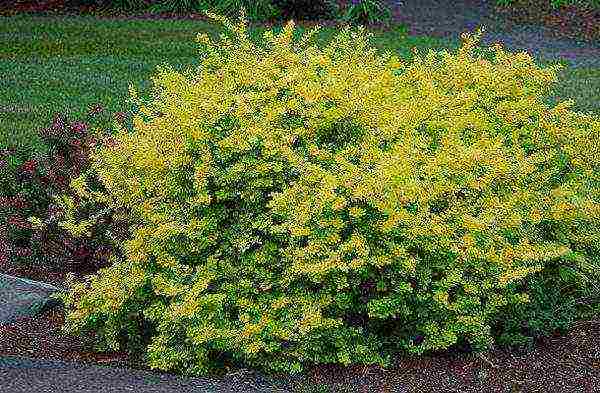
Barberry Thunberg Aurea
The Aurea variety is characterized by the correct shape, and the height of the shrub rarely reaches 70–90 cm. It belongs to a slow-growing type of plant, but this fact does not stop landscape designers and ordinary lovers of beauty, since this bush is in perfect harmony with the usual greenery and goes well with other varieties barberry.
The leaves are diamond-shaped, and the color can vary from bright yellow in the spring to golden, interspersed with orange in the fall. In the case when this type of shrub is in the shade, the foliage acquires a greenish-yellow tint.
Erecta

Barberry Erecta
Barberry Thunberg Erecta has a columnar form of a bush, and the height can reach 100 cm. Young branches grow strictly in a horizontal position, only a few branches are able to deviate to the side.
This ornamental plant stands out brightly against the background of the rest of the plantings with its bright green foliage and a very interesting crown shape.
Barberry Erekta belongs to frost-resistant varieties and looks great in a mixborder.
Green Carpet
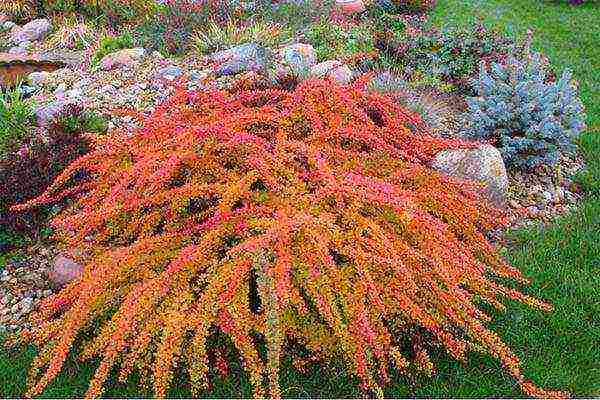
Barberry Thunberg Green Carpet
Green Carpet is a spreading and cushion-shaped variety of barberry, whose height can reach 50 cm, and width - about 100 cm.This plant is characterized by light green foliage and a rather dense spherical crown.
With the onset of autumn, the foliage is transformed and pleases with a reddish tint.
The Green Carpet shrub is very unpretentious and is great for our climate. It looks great both in a group composition with other conifers and deciduous plants, and in an isolated location on slopes and small hills.
Golden Ring

Barberry Golden Ring
Barberry Thunberg Golden Ring belongs to the purple-leaved species and is in many ways similar to the dark purple form, in contrast to which it stands out with an elegant and refined golden-yellow edging of leaves, which has a very beneficial effect on the appearance of the plant.
This type of barberry practically does not freeze and looks harmonious in border groups and in trimmed hedges. The Golden ring variety was bred in 1950 and was already in great demand in the landscape composition of a suburban area or urban landscaping.
Red Rocket
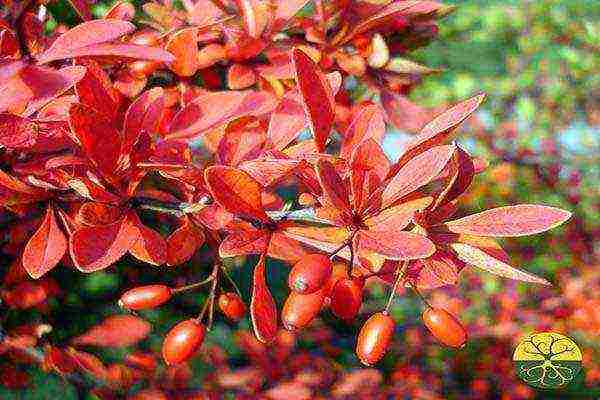
Red Rocket
Red Rocket is another striking representative of the group of purple-leaved species with a columnar crown shape. The height of an adult plant can reach 100 cm. The branches are directed horizontally upwards and are covered with abundant short branches. The shade of the foliage is red-brown.
The variety looks quite natural both as a separate plant and as part of all kinds of compositions formed on a contrasting combination of color and geometric shape. Also barberry Red Rocket looks great in monotonous and trimmed hedges.
The degree of winter hardiness is medium.
Bagatelle
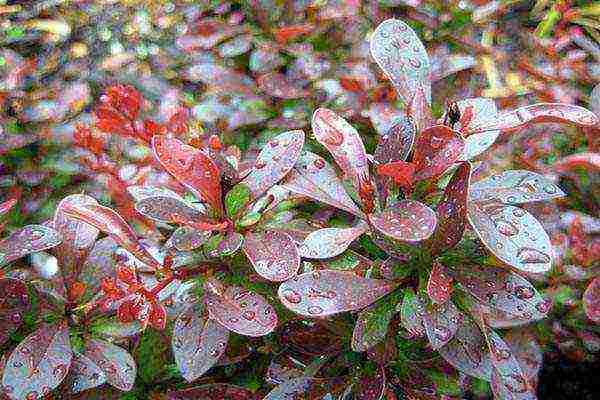
Barberry Bagatelle
Thunberg barberry of the Bagatelle species is characterized by its spherical and rather compact crown shape with small branches and very rich red-brown leaves. This beautiful and deciduous ornamental plant has a crown height and width of about 40 cm.With proper care, the annual growth is about 2 cm.
Young foliage has a dark pink hue, and inside the shrub itself it is greenish with crimson blotches. The foliage is purple or reddish brown in color, and the shape is ovoid with a length not exceeding 1 cm.
In the autumn period, the Bagatelle barberry variety practically does not change its color.
Admiration
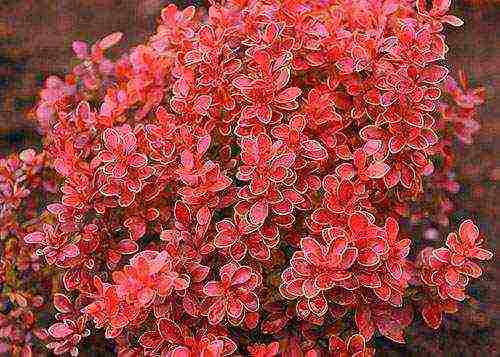
Barberry Thunberg Admiration
Barberry Admiration is one of the world's most promising shrub species, honored with the 2009 Royal Horticultural Society's Annual Award.
This ornamental plant is a small bush with a round, rather dense, but not uniform crown. The height and diameter of the crown reaches no more than 30-40 cm, and the annual growth is no more than 3-4 cm in height and about 8 cm in breadth.
The short and faceted branches of a brown shade are covered with small needles. The Admiration barberry variety has edible fruits that ripen in October, characterized by an elongated outline and bright red color.
It is very light-loving, but it also tolerates partial shade. It is quite resistant to aridity and heat, and undemanding to the level of soil fertility. It has good winter-hardy qualities, however, during a cold and snowless winter, branches can freeze over. Quite often, it loses many shoots after the winter period, but very easily recovers by the flowering period.
Maria
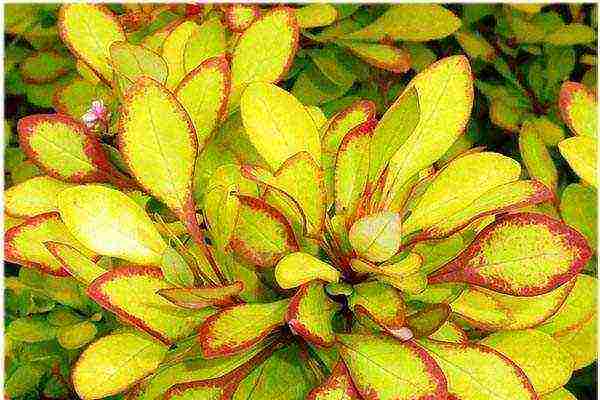
Barberry Thunberg Maria
Tunberg barberry Maria is a rather slow-growing ornamental bush with erect branches, growing up to 150 cm.
The crown is represented by a columnar shape, rather sweeping, but at the same time dense. Early shoots are expressed in pink-orange color.
The leaves are large, with a yellow-gilded tint and bright pink edging. In the autumn, this shrub turns into an orange-red and looks very impressive.
Flowers are yellowish, bloom at the end of May. The fruits are small, bright red, shimmering in the sun, ripen in October.
The place for planting must be chosen sunny, due to the fact that when located in the shade or partial shade, the plant loses its color intensity and shape. With constant and full watering, it is resistant to direct sunlight. During severe drought, it can burn and crumble. It is undemanding to the soil, but it grows better on moist and rich soils, in principle, like any plant.
It perfectly tolerates a decorative haircut, therefore it is very much in demand among landscape designers when creating topiary forms.
It is completely winter-hardy and looks harmoniously in medium-sized borders, a wide variety of color compositions, as well as when creating a rock garden.
Orange Dream
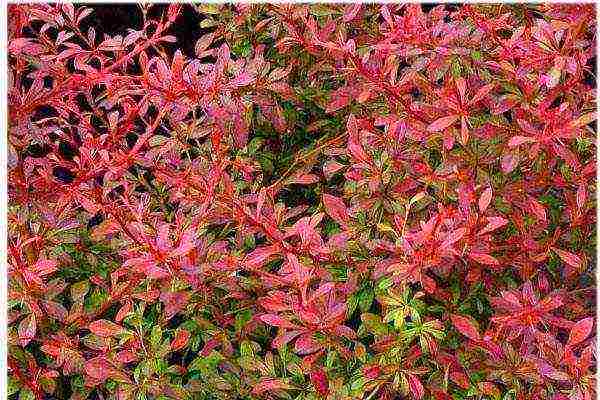
Barberry Thunberg Orange Dream
Barberry Thunberg varieties Orange Dream can be safely called a festive shrub. You can never ignore the part of the garden in which these dwarf and evergreen plants with a height of no more than 60-70 cm are located against the background of greenery.
The branches are rather thin and widely spread. The foliage is rather small, lanceolate and deep orange-red in spring and summer days, and burgundy red in the fall.
This variety of barberry blooms in small inflorescences in late May - early June, and in late August - early September, fruits appear on the shoots - reddish elliptical berries, which are exclusively decorative and are not inedible.
Orange Dream prefers a sunny location on the site and does not tolerate waterlogging. Quite winter-hardy.
Harlequin

Barberry Thunberg Harlequin / Harlequin
The Harlequin Thunberg barberry is characterized by a spreading and very large crown with small branches highlighted by the original mottled foliage.
This thorny plant belongs to slow-growing varieties, whose annual growth, with sufficient care, can reach 10-12 cm.The height of the Harlequin variety Thunberg barberry can reach 140-150 cm, and its width is 120 cm.
The shape of the crown is spherical and spreading. Young branches are characterized by a yellowish or crimson-red hue, which then turns to purple-brown. The foliage is small, about 3 cm long. The thorns present on the branches can reach 2 cm in length.
The shrub blooms very abundantly and for about 3 weeks. In most cases, the Harlequin blooms at the very end of May. The buds, located along the entire length of the branch, are single or composed in a single inflorescence of several buds, yellowish from the inside, and reddish from the outside. The berries have a pronounced ellipsoidal shape, with a bright red tint shimmering in the sun. The fruits ripen in the middle or end of September and remain on the bush for quite a long time. There are often cases when the foliage is fallen, and the berries are on the bush all winter.
The Harlequin barberry variety loves alkaline soil and is quite photophilous, has winter-hardy qualities and perfectly tolerates urban conditions.
Video "Barberry Thunberg overview of variegated varieties"
Planting and grooming recommendations
The location for most varieties does not play a significant role, however, there are varieties that are very demanding in this regard. In the process of growing, the Thunberg barberry is hardened and fully mastered in a new place. Other things being equal, this shrub will be better when it is located in a place open to the sun and protected from the cool breezes of the wind (the upper parts of the southern and western slopes or slopes are excellent),in well-drained soil.
In a situation where the soil in the selected place has a rather heavy and heavily permeable structure, the substrate for planting should be specially prepared. One of the best options would be a mixture of turf, humus and sand in a 2: 1: 1 ratio. During the planting process, the pits should be at least 50 cm deep and wide and filled with prepared substrate.
Ornamental shrubs do not need repeated watering and in the absence of long-term drought, natural precipitation will be sufficient. In the process of planting, it is advisable to make near-stem holes. The irrigation procedure itself should be carried out without irrigating the foliage - strictly under the root system.
In the spring, it will be very useful to fertilize the barberry with good humus, compost or other organic matter. In autumn, the trunks should be mulched with loose materials such as peat and loose compost.
Barberry Thunberg and its just a huge number of species are excellent for making the garden more decorative, and the degree of winter hardiness and resistance to external factors is highly appreciated by landscape designers in our climatic zone.
Gardeners use this unassuming plant mainly to create
hedge
... However, it is not worth limiting the possibilities of this shrub in this way, since many completely different species and varieties belong to the genus Barberry, each of which is unique in its own way.
We can safely say that the "talent" of the barberry (Berberis) on the garden scene is greatly underestimated. As a rule, on the plots you can contemplate only one type of this plant - the Thunberg barberry, whose destiny is to act as a hedge. And such its use is really justified, because this shrub about 2 m high is hardy, grows well both in the sun and in openwork shade, and, most importantly, it tolerates pruning well. But after all, the same Thunberg barberry has a lot of very beautiful varieties, not to mention other types of barberry, which many of us simply do not know about. How not to correct this annoying injustice? So, meet the red-leaved dandy barberry 'Atropurpurea', golden yellowGolden Torch 'variegated with marbled pattern ‘Rose Glow ' deserve to take pride of place in any garden.
At night, a frost covered the oval leaves of the Thunberg ‘Atropurpurea’ barberry with glittering ice crystals.
Thunberg barberry 'Atropurpurea' In winter, when the 'Atropurpurea' barberry has dropped its leaves, its branches are still adorned with scarlet fruits.
Barberry 'Atropurpurea' in winter After rain, the fruits and leaves of the 'Rose Glow' barberry (Berberis thunbergii) shine in the sun.
Thunberg barberry (Berberis thunbergii) In autumn, its leaves look especially beautiful, acquiring marble colors in pink, red and white.
In the midst of autumn, the ‘Red Chief’ barberry, tannery and asters put on a bright and colorful show.
‘Red Chief’ barberry, tannery and asters ‘Golden Torch’ barberry captivates with bright yellow foliage. Due to its low growth (only 1 m), it is suitable for planting in a mixed flower garden of herbaceous perennials.
‘Golden Torch’ Barberry Under the fluffy snow cover, the dark red leaves of the barberry left on the branches look especially striking.
Under the fluffy cap of snow
Due to the compactness of the crown and the height of only 1 m, barberries of these varieties are excellent for planting in large flower beds. Surrounded by floral herbaceous perennials and ornamental grasses, they will become structure-forming components, even in winter, when the shrubs shed their luxurious leaves.
Are even meter high bushes too big for your site? There are “barbarisks” for this case too, their height is only 30-40 cm. These little ones include the Thunberg barberry of the red-leaved dwarf varieties ‘Nana’ and ‘Bagatelle’.
Further more. Present to your attention
evergreen variant of a plant , namely
box-leaved barberry (Berberis buxifolia) 'Nana' .
'Nana' boxwood barberryAdvice: where mushroom diseases and moths mercilessly destroy boxwood, this type of barberry can be an excellent alternative to it. However, in regions with a cold climate in severe winters, it can freeze a little - be sure to take this into account.
Barberries have another nice bonus:
in spring, shrubs are able to please with magnificent floral decoration ... Small yellow flowers open in May-June, depending on the species. And in combination with the dark red leaves of the Thunberg barberry, they form a great contrast. And in the fall, these shrubs are hung with red (in some species, black) fruits, which look advantageous primarily in deciduous barberries - but only until our feathered friends fly in for a portion of vitamins in winter.
Evergreen beauties for a flower garden
Along with deciduous barberries, such as the Thunberg barberry, there are also evergreen species. We have already mentioned one of them. This is box-leaved barberry (Berberis buxifolia) 'Nana' - a dwarf shrub with a height of only 50 cm. It is perfect for low hedges.
Remains compact at a height of 1.5 m Barberry Frikarta (Berberis frikartii) 'Amstelveen'.
Barberry Frikarta 'Amstelveen' It grows mainly in partial shade, like Gagnepein's barberry (Berberis gagnepainii) 'Klugowski', the branches of which, as they grow, picturesquely slope to the ground.
'Klugowski' Barberry For dense hedges of one meter height is greatgray-white barberry (Berberis candidula) 'Jytte' with a dense pillow-shaped crown.
Barberry gray-white 'Jytte'
Healer plant
Common barberry (Berberis vulgaris) used in folk medicine for a long time. However, the dried roots and bark of this shrub are still used today. Tea made from them helps with digestive problems, as well as diseases of the liver and gallbladder.
Common barberry (Berberis vulgaris) However, be careful: the alkaloids contained in the plant in case of kidney problems can provoke a deterioration in health. But the red, vitamin-rich fruits can be safely used for food, as well as to prepare juices and jellies from them. Dry sour berries can be added to muesli. And Tatya Yagodka will tell you about the cosmetic properties of barberry again: do-it-yourself cosmetics.
Read also:
- Why do you need barberry
- Barberry - comes from childhood
- Vitamins on the bush: features of growing actinidia, lemongrass and barberry
- Guests from the taiga: Chinese lemongrass and Amur barberry (video)
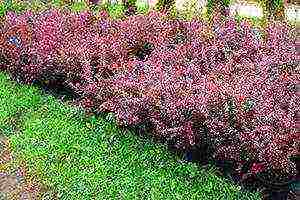 To give the site some attractiveness and originality, the barberry shrub is often used in landscape design. An ornamental plant is appreciated for the fact that its appearance is constantly changing throughout the year. This brings a certain variety to landscape compositions.
To give the site some attractiveness and originality, the barberry shrub is often used in landscape design. An ornamental plant is appreciated for the fact that its appearance is constantly changing throughout the year. This brings a certain variety to landscape compositions.
One of the most spectacular and popular shrub species is the Thunberg barberry (Berberis thunbergii). Its homeland is the Far East, where the shrub grows on rocky mountain slopes. And since 1864, it has been cultivated practically throughout Russia.
General characteristics of Thunberg barberry varieties
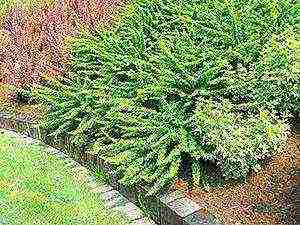 The Thunberg barberry shrub has a wide variety of decorative forms and varieties. The most popular ones are:
The Thunberg barberry shrub has a wide variety of decorative forms and varieties. The most popular ones are:
- Atropurpurea Nana;
- Golden Ring;
- Aurea;
- Bagatelle;
- Green Carpet;
- Kobold.
This type of barberry, depending on the variety, has green, yellow or purple foliage and arched branches with thin single spines. Its flowering period lasts from May to June. The fruits ripen in the fall and often do not fall off until the end of winter.
Thunberg barberry varieties are quite unpretentious in terms of soil, they tolerate heat and drought well. However, they grow poorly in wetlands and where groundwater is close.This type of barberry is grown in sunlit places, and some varieties in partial shade. The shrub easily recovers after frost, but it is advisable to cover young plants for the winter. One of the advantages of the species is resistance to fungal diseases.
Typically, varieties of barberry Thunberg are used in gardens and parks as hedges and borders for zoning the territory, for creating decorative groups and in single plantings. This type of barberry is great for creating a Japanese garden, and is also used to anchor the banks of irrigation systems.
Barberry Thunberg Atropurpurea Nana
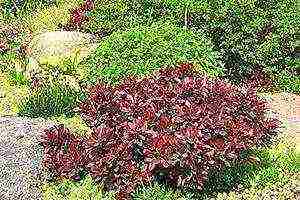 Red-leaved variety, dwarf form of barberry Atropurpurea. Main characteristics:
Red-leaved variety, dwarf form of barberry Atropurpurea. Main characteristics:
- adult bushes grow about 61 cm high and no more than 91 cm wide, the crown is compact, cushion-shaped;
- in the summer, the foliage has a purple color; with the arrival of autumn, it changes its color and becomes bright red;
- in spring (April - May) the barberry of Thunberg Atropurpurea Nana is hung with small yellow flowers;
- fruits are deep red, glossy, ripen in October and remain on the branches even in winter;
- good frost resistance;
- loves a sunny location;
- It is commonly used in single plantings, decorative bands, rockeries and to create curbs.
For planting, it is recommended to purchase acclimatized barberry seedlings of Thunberg Atropurpurea Nana, grown in a plastic container along with fertilizers. Because in the process of digging a seedling out of the ground, damage to the roots is possible, which can negatively affect the further development of the plant.
Barberry Thunberg Golden Ring
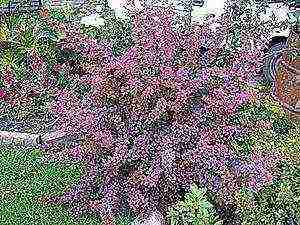 A tall variety with a unique color. Main characteristics:
A tall variety with a unique color. Main characteristics:
- in height and width the bush reaches 2-3 m, the crown is branched, spreading;
- foliage of dark purple color has a thin yellow-green border, and with the arrival of autumn, the leaves become rich red;
- in spring (in May), the Golden Ring Thunberg barberry is decorated with small yellow inflorescences;
- fruits are coral-red, glossy, ripen in October;
- winter hardiness of the variety is high;
- grows well in areas illuminated by the sun, and the decorative effect of the leaf disappears in the shade;
- great for landscape compositions, hedges, and also used as a tapeworm, well-cut.
Barberry Thunberg Golden Ring is prone to defeat by barberry aphids. To prevent the bushes from damage, it is necessary to carry out preventive spraying of plants with insecticides in the spring.
Barberry Thunberg Aurea
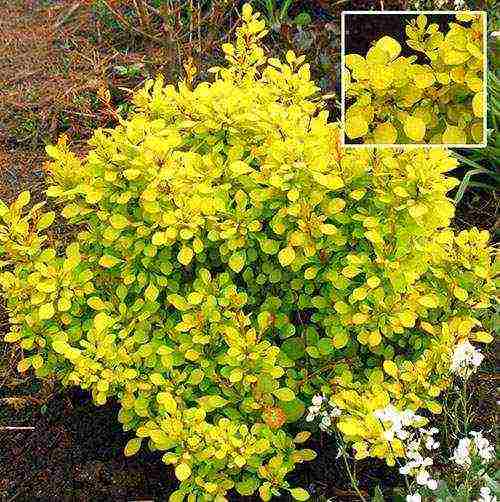 Low-growing yellow-leaved variety of barberry. Main characteristics:
Low-growing yellow-leaved variety of barberry. Main characteristics:
- the bushes grow up to 0.8 m in height and 1 m in width, the crown is compact, round;
- the variety is characterized by yellow foliage with a soft golden tint; with the arrival of autumn, it becomes yellowish-orange in color;
- the flowering of the barberry Thunberg Aurea begins in May, the flowers are golden yellow, collected in neat inflorescences;
- fruits of deep red color, ripen in September and stay on the branches all winter;
- has good frost resistance;
- the foliage of the shrub quickly dries up and falls off under the influence of direct sunlight, and in the shade the color of the leaves becomes light green, therefore it is recommended to plant it in partial shade;
- used in single plantings and decorative groups, to create curbs and hedges.
Barberry Thunberg Aurea can be planted near dark junipers and blue spruces. Thanks to the original bright yellow color of the foliage, it will look impressive against this background.
Barberry Thunberg Bagatelle
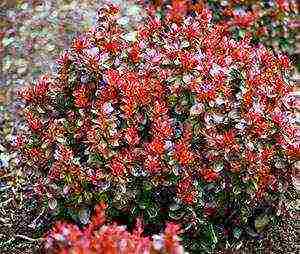 Ornamental dwarf shrub. Main characteristics:
Ornamental dwarf shrub. Main characteristics:
- bush with a height and crown diameter of a maximum of 40 cm, the crown is dense, pillow-shaped;
- in summer, the leaves are crimson-red, in autumn they acquire a bright red color;
- barberry Thunberg Bagatelle begins to bloom in May, flowers are white, sometimes with a yellowish tinge;
- the fruits are deep red, ripen in October and last throughout the winter;
- has good winter hardiness;
- the variety is photophilous and resistant to drought;
- used to create miniature borders, design alpine slides, balconies and terraces, looks great in all flower beds.
If planted in the shade, it can lose its original leaf color and turn greenish. Therefore, for a more intense color, it is advisable to plant the Thunberg barberry Bagatelle in the sun.
Barberry Thunberg Green Carpet
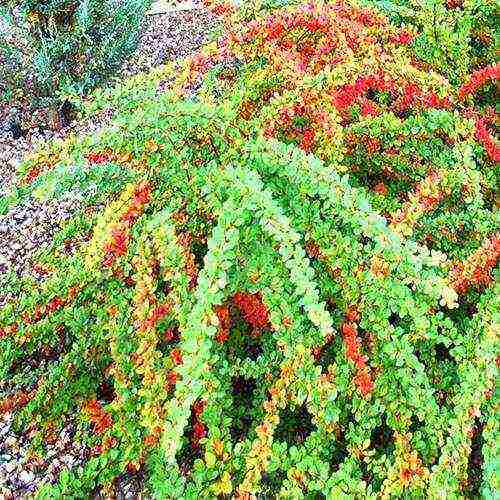 Medium-sized Dutch variety. Main characteristics:
Medium-sized Dutch variety. Main characteristics:
- the bushes grow up to 1 m in height, the crown diameter is 1.5 m, the crown is compact, round;
- in summer, the foliage is light green, with the arrival of autumn it becomes bright red;
- the flowering of the barberry Thunberg Green Carpet begins in May, the flowers are yellow, collected in small clusters;
- fruits are glossy, coral in color, ripen in September;
- good frost resistance;
- exposure to the sun is recommended, does not like shade, heat and drought resistant;
- the variety looks great in combination with deciduous and coniferous shrubs with various colors and crown shapes, is used in single, group plantings and as a ground cover plant.
It is recommended to plant the Thunberg Green Carpet barberry in spring or autumn. If the planting is single, then the gap between the bushes should be at least 1.5 m. And when creating a hedge, you need to dig a trench and arrange the plants, 2 bushes per 1 linear meter. m.
Barberry Thunberg Kobold
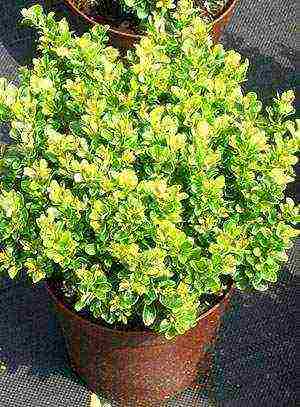 Low-growing densely branched variety. Main characteristics:
Low-growing densely branched variety. Main characteristics:
- the height of the bush and the diameter of the crown do not exceed 50 cm, the crown is cushion-shaped, compact;
- in the summer, the foliage is dark green, with the arrival of autumn it turns into golden yellow or bright red;
- flowering of barberry Thunberg Kobold begins in May, yellow flowers are collected in neat inflorescences;
- fruits are glossy, pink or red, ripen in September;
- good winter hardiness;
- photophilous, does not like shadow;
- it is used in group plantings, garden and park tree and shrub compositions, to create borders and design alpine slides, lends itself well to cutting and pruning.
In the second year after planting, the Thunberg barberry Kobold is recommended to be fed with nitrogen fertilizers. Subsequent feeding is carried out every 3-4 years.
With the help of barberry bushes, you can create interesting and unique landscape compositions. A large number of different varieties of Thunberg barberry allows you to choose the right foliage color and the required height. And simple agricultural technology makes it possible to take care of the shrubs easily and with pleasure.
The use of barberry Thunberg in landscape design - video
Yellow, green, orange, pink, red, burgundy spots of barberry in the garden attract the eye and become the heart of any composition. Choose one or more varieties to color your garden.
The first mention of barberry dates back to 650 BC - even then the Assyrians knew the beneficial properties of the thorny bush. But it appeared in garden design much later, in the middle of the 19th century. Then the bush growing on the mountain slopes of the Chinese provinces and in Japan attracted the attention of breeders, and since then the number of its varieties has grown significantly.
Unfortunately, our climate does not allow growing many interesting varieties of barberry - they cannot stand harsh winters. However, even among the options that have taken root in Russia, you can find a worthy decoration for your garden collection.
Barberry Thunberg Admiration
Barberry Admiration belongs to the miniature varieties of this shrub - it grows no more than half a meter in height, forming a dense spherical crown. In summer, its leaves are yellow and orange, and by autumn they turn scarlet, with a yellow edging. The shrub blooms in May, and in September it is covered with red berries.
Barberry Thunberg Coronita
The bush of this variety grows quickly and in a few years after planting it reaches one and a half meters in height and a meter in width. However, active growth stops there, and even with the most successful agricultural technology, Koronita will not become a giant. The leaves on the young branches of the bush are bright red, and dark purple on the shoots of past years. The characteristic border remains in both cases.
The name of the barberry has Arabic roots and means "like a sea shell". This epithet was awarded to the petals of a barberry flower, and then the bush itself.
Barberry Thunberg Harlequin
Harlequin's unusual variegated foliage is eye-catching. The height of an adult bush is about one and a half meters, the width reaches 2 m, so it needs a lot of space. The bush grows quickly, giving an increase of up to 15 cm in a year. True, young seedlings of the Harlequin variety are afraid of frost, and in the first couple of years it is better to cover them for the winter.
Barberry Thunberg Rose Glow (Rose Glow)
Rose Glow bush is a real "two in one" in the garden. The bark and leaves of young shoots are painted in a variegated pink color, and the adult branches and leaves on them are purple-violet, almost gray-gray. On a large plant (and the Rose Glow bushes reach 1.5 m in height) it looks like a bright bouquet in a wrapped in a discreet tone.
Barberry Thunberg Golden Rocket
Growing the bright golden-green Golden Rocket to its maximum height is not easy - its shoots often break under the weight of snow and freeze under the weight. Usually the bush is formed up to 70 cm in height, and the crown for the winter is tied or wrapped in a net.
Despite the decorativeness of the barberry, in a number of US states and in New Zealand, this plant is prohibited to grow and sell. The official reason is that the barberry is an invasive plant and tends to "survive" others in their place.
Barberry Thunberg Orange Rocket
The narrow, vertical Orange Rocket bushes look great in group plantings. The bush grows slowly and only in height - in width it will reach 40 cm and stop there. But the rich orange color of the foliage acquires already in the spring, turning red only by autumn.
Barberry Thunberg Aurea (Aurea)
The slow-growing bush of the Aurea variety is characterized not only by yellow or slightly greenish foliage, but also by horizontal crown formation. In width, it grows up to 1 m, but in ten years it will hardly reach 80 cm in height. The color of the leaves is best manifested in sunny areas. This barberry is not afraid of frosts and is indifferent to the soil, but it does not like strong winds.
Barberry Thunberg Cabernet (Kabernet)
Another horizontal bush of unusual colors can become the center of attention, because the foliage of fiery shades on it is the whole season. In spring it is crimson, in summer it is wine, and by autumn it becomes red-orange. True, the Cabernet crown will have to be subjected to a preventive haircut annually, otherwise it can acquire the most bizarre shapes.
Ten years ago, Italians found a way to extract a substance from barberry, similar in effect to the famous "Viagra".
Barberry Thunberg Maria (Maria)
Golden in spring and red by autumn, the Maria variety barberry is quite whimsical - it requires pruning twice a year, is afraid of drafts and grows very slowly. However, if you decide to plant it and give the bush time, then in ten years it will become a lush bright ball of a meter in diameter.
Barberry Thunberg Red Carpet (Red Carpet)
Barberry Red Carpet is a real fireworks of colors. There is at once the whole palette of colors: from delicate spring greenery to autumn gold and scarlet berry shades. Sprawling curved branches take up a lot of space and are strewn with thorns, so it is better to plant Red Carpet away from the paths. The bush is frost-resistant, but does not tolerate waterlogging and prefers alkaline soils.
Of course, it is difficult to single out the finest varieties among barberries, because each of them is good in its own way.If you also love these bright, attractive shrubs, share with us photos and the names of your "favorites".


